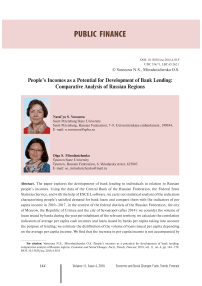Miroshnichenko O.S. People's incomes as a potential for development of bank lending: comparative analysis of Russian regions
Автор: Voronova Natalya S., Miroshnichenko Olga S.
Журнал: Economic and Social Changes: Facts, Trends, Forecast @volnc-esc-en
Рубрика: Public finance
Статья в выпуске: 4 (58) т.11, 2018 года.
Бесплатный доступ
The paper explores the development of bank lending to individuals in relation to Russian people's incomes. Using the data of the Central Bank of the Russian Federation, the Federal State Statistics Service, and with the help of EXCEL software, we carry out statistical analysis of the indicators characterizing people's satisfied demand for bank loans and compare them with the indicators of per capita income in 2010-2017, in the context of the federal districts of the Russian Federation, the city of Moscow, the Republic of Crimea and the city of Sevastopol (after 2014): we consider the volume of loans issued by banks during the year per inhabitant of the relevant territory, we calculate the correlation indicators of average per capita cash incomes and loans issued by banks per capita taking into account the purpose of lending; we estimate the distribution of the volume of loans issued per capita depending on the average per capita income. We find that the increase in per capita income is not accompanied by a proportional increase in bank loans per capita...
Provision of loans to people, people's incomes, income inequality, ltv, dsti, consumer behavior
Короткий адрес: https://sciup.org/147224070
IDR: 147224070 | УДК: 336.71 | DOI: 10.15838/esc.2018.4.58.9
Текст научной статьи Miroshnichenko O.S. People's incomes as a potential for development of bank lending: comparative analysis of Russian regions
Population’s consumer loan is the most important bank activity, which generates income and causes adoption of risks. The classic approach of banking theory which has proved its worth in all countries and in the global economic space implies a relation between loan liabilities of individual borrowers and household incomes, which is also emphasized by the banking regulator. Modern macro-prudential requirements in many countries include indices governing retail lending such as LTV and DSTI1.
For the population, the reasons and consequences of attracting bank loans to the family budget are very diverse, but they are divided into two groups of consumer loans.
In the first group includes bank loans for the population to expand consumption, invest in the development of individual abilities, improve the quality of life, which, with a commensurate borrowers’ debt burden and incomes leads to an increase in individuals’ welfare and is one of the factors in the country’s economic growth.
The second group includes bank loans as a source to pay off imbalance of deficient income and necessary daily expenses are used to refinance other debts. Under competent credit management, such loans on a limited time interval are able to generate income and even provide banks with profitable existence; however, in an unchanged situation with household incomes, they do not contribute to population’s welfare, are not a factor in economic growth, and their consequences are not only economic, but also psychological [1; 2; 3] and social [see, for example, 4; 5].
For banks, the development of lending of the second type of lending relations leads to a limited potential growth of quality loan portfolios, income from loans and is accompanied by the development of potential risk factors.
Since the geographical extent of the Russian territory determines the differentiation of important economic indicators such as per capita income, GRP etc. in this paper the relations between household income and bank loans is studied taking into account data of separate Russian regions, which ensures comparability and development of results obtained by other Russian authors [see, for example, 6; 7; 8; 9; 10].
In this regard, the purpose of this research is to identify, systematize, and critically assess the current trends in the development of bank lending in comparison with the average per capita income of the population taking into account the geographical differentiation of the values of indicators under study. To achieve this goal, the following objectives were set and addressed:
– to assess the correlation between per capita income and loan value granted by banks per capita, to identify regional features of the analyzed indicators;
– to study population lending taking into account the purpose of loans with regard to the average per capita income;
– based on analysis of population’s income as a potential for bank lending development, to identify trends in bank lending development.
Coverage of the problem
A large number of studies by Russian and foreign authors are devoted to the issues of consumer loans, the impact of loans on consumer spending, the relations between household income and bank income and risks.
One of the areas of such research involves assessing the role of bank loans in household finance. According to the opinion of a team of authors under the leadership of V. Mau, “the contribution of bank loans to household finance over the past few years in Russia is negative” [11, p. 161]. Similarly, a negative assessment of the current situation with population lending is given by G.A. Sharinova. When studying the relations between the income level and loan liabilities in the Republic of Kalmykia, Sharinova comes to a conclusion that in order to improve the situation with the population’s debt load it is necessary to stabilize the economic situation in the region, increasing incomes, and intensifying work to increase financial literacy
[12, p. 81]. The relations between financial literacy and household loan behavior are also studied by foreign authors [see e.g., 13; 14].
M.Yu. Malkina, studying uneven distribution of consumer loans between Russian regions, argues that high loan value does not improve the financial status of the disadvantaged regions, but notes there is a decrease in regional inequality in terms of population lending during 2001–2016 [15, p. 2136]. Khatskevich E.M., Semer’yanova A.Y., and Tatarinova L.Y. conclude that it is necessary to increase the availability of loans for the population on example of the Siberian region [16, p. 35].
The prerequisites for the country’s possible transition to a harmonized economic system produces the direction of the domestic economy from “public economy” to “individual economy” [17, p. 56]. The growing standard of living and the country’s sustainable socioeconomic development are defined as ways to prevent possible negative processes on the loan market [18, p. 138].
The next area of research into consumer loans involves studying consumer loans in connection with deposits, identifying factors contributing to the development of lending and savings processes [19; 20]. Thus, N.A. Petukhov established a direct correlation between the average loan debt in rubles per capita, and GRP per capita by Russian regions: “With the growing GRP, there is an increasing consumer debt in rubles in the region” [19, p. 51]. E.B. Ershov, and O.N. Ladreva conclude there is a positive short term and negative long-run relation between savings and loan [20, p. 349].
Another area of research into bank lending is identifying factors determining the individuals’ loan behavior, encouraging the population to apply for loans and contributing to the formation of household loan arrears.
The main role in the formation of population’s loan demand belongs to the unemployment rate, consumer confidence and inflation dynamics [21, p. 251]; borrower’s age and sex, availability of payment cards (debit and credit), income, availability of a mortgage loan are significant factors in the likelihood of individual’s loan arrears [22, p. 113]; amid population’s reducing income a reduction in individual lending should be expected [23, p. 62].
Foreign researchers examine bank loans from the perspective of the impact of household debt on macro-economic variables and the influence of government’s regulatory measures on the development of household lending.
American researchers Edmond Berisha and John Meszaros believe that increases household debt is analogous to income redistribution in the US: amid economic recession, lower-income households were able to maintain the consumption level while high-income households received additional income, which further aggravated income inequality [24, p. 93]. Economic growth more favorably affects the welfare of households with high income compared to low-income households [25, p. 363]. High-income households widely use more fine-tuned financial instruments [26].
Researchers from the European Central Bank, Miguel Ampudia, Hasvan Vlokhoven, and Dawid Zochowsk, identify the relations between households’ loan arrears with factors such as changes in interest rates, income and housing prices [27, p. 250]. Hem C. Basnet and Ficawoyi Donou-Adonsou, based on US data prove that credit card debt is the lower, the higher is the holder’s level of education; and the higher, the more loans households take for shopping on-line [28, p. 11].
According to Edmond Berisha and John Meszaros, low interest rates, changes in the regulatory environment for financial institutions and technological advances in credit risk management were important factors that influenced bank lending to American households; household debt increases with a decrease in economic growth and rising unemployment [24, pp. 93–94]. The macroprudential policy acts as a factor limiting the increase in lending in general and especially – lending to households [29, p. 203]; the reduction in public debt on bank loans is most effectively affected by regulatory LTV, to a lesser extent – by an increase in real estate taxes (on mortgage debt) and tightened fiscal policy [30, p. 47]. Merike Kukk notes the negative macroeconomic consequences of increases DSTI in data for Estonia [31, p. 764]. Using data of the EU countries, Gross Marco and Javier Poblacion compare the regulatory impact of LTV and DSTI and come to a conclusion that DSTI more effectively adjusts the credit risk on bank loans to the population [32, p. 510]. The impact of the tax policy on households’ financial decisions is also analyzed – [33] shows the impact of the tax regulation of income in China at different stages of economic growth on the development of the country’s banking system.
Thus, the study of bank lending in the scientific literature is represented by a wide variety of areas. However, the study of loans granted by banks to the population in comparison with per capita income on the example of the Russian regions is very relevant. The hypothesis of the present study is related to the difference in population’s loan preferences in Russian regions depending on the level of per capita income as a potential for the development of lending to individuals.
Information and methodological research framework
The study is based on statistics at the official website of the Bank of Russia, section “Statistics. Regional breakdown”, subsection “Information on funds invested and raised”, part “Loans granted to resident individuals (regional breakdown)” for the period 2010– 2017. Data on loans are presented based on the borrower’s location regardless of the place of state registration of the lending bank, which ensures their correct analysis in comparison with the average per capita income of the population. The data source is information from commercial banks’ reports submitted to the Bank of Russia in the form2 0409302.
Annual data on population “Demography. Number and structure of the population” and on average per capita monthly income “Average per capita monetary income on subjects of the Russian Federation” were selected for the study; they are presented at the official website of the Federal State Statistics Service.
The data are grouped in the territorial breakdown by Russian federal districts. The special position of the capital region of Russia has predetermined the formation of the statistical framework of this study with separating the indicators of Moscow from the indicators of the Central Federal District. Moreover, during the analyzed period the composition of federal districts changed due to the Republic of Crimea annexed to Russia in 2014 and the inclusion of the Crimean federal district in 2016 in the SouthernFederal District. For the purpose of analysis, indicators of the Crimean Federal District (the Republic of Crimea and Sevastopol) are distinguished in the statistics, but all corresponding dates are excluded from indicators of the Southern federal district. Data from the North Caucasus federal district are present separately in the sample since 2011.
For the purposes of the study, a statistics database of analyzed indicators (loans to individuals granted by banks, population and per capita income) was formed in the context of eight federal districts (Central excluding Moscow, Northwestern, Southern, North Caucasus, Volga, Ural, Siberian and Far Eastern) with cities of Moscow, Sevastopol, and the Republic of Crimea standing separately.
Results
Income as a primary source of loan repayment determines the individual’s ability to borrow money from a bank, act as a criterion for creditworthiness. Changes in income directly affect the volume and quality of bank loans to individuals and determine the development potential of bank lending to certain categories of borrowers.
In Russia, the average per capita income of the population is significantly differentiated by territory ( Fig. 1 ).
According to Figure 1 , the highest per capita income (in isolation from other territories) is concentrated among the population of Moscow. By the end of the analyzed period, per capita income in all regions grows; per capita income of the population in the Central (excluding Moscow), Far Eastern, Northwestern and Ural federal districts increase most rapidly.
Bank loans are used as a source of defraying costs by the population in all regions. Data on loans to individuals in the context of federal districts excluding Moscow, the Republic of Crimea and Sevastopol are presented in Fig. 2 .
Figure 1. Distribution of per capita income in Russia by territory, rubles
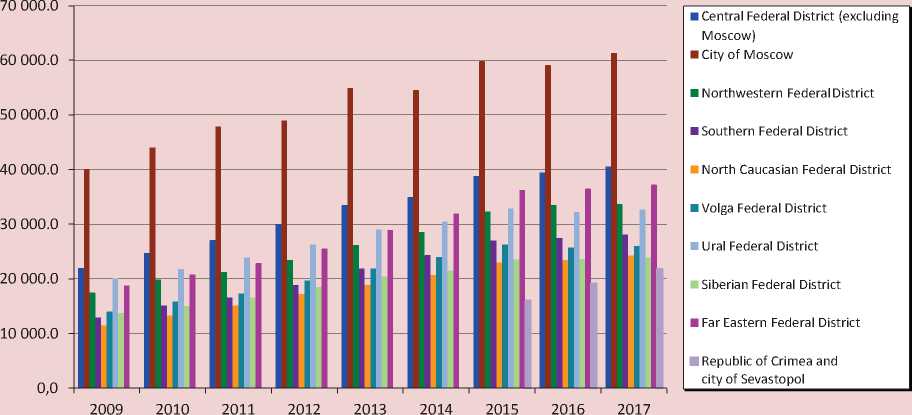
Source: Per capita income by constituent entity of the Russian Federation. Available at: site/population/urov/
Figure 2. Distribution of loans to resident individuals in rubles and foreign currency for 2010–2017, million rubles
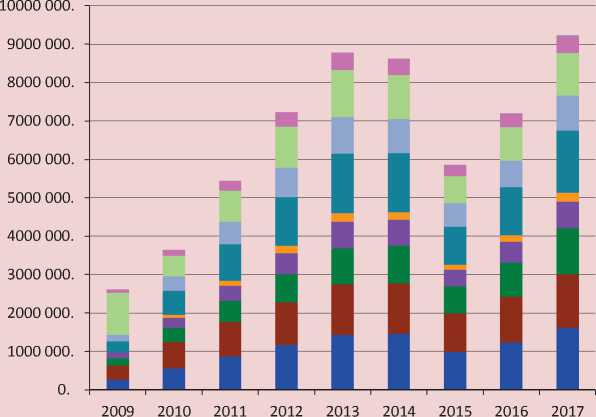
-
■ Republic of Crimea and city of Sevastopol
-
■ Far Eastern federal district
-
■ Siberian federal district
-
■ Ural federal district
-
■ Volga federal district
-
■ North Caucasian federal district
-
■ Southern federal district
-
■ Northwestern federal district
-
■ City of Moscow
-
■ Central federal district (excl Moscow)
Source: Loans to resident individuals (regional breakdown). Available at:
Figure 3. Distribution of population in the Russian territory in 2010–2017, thousand people
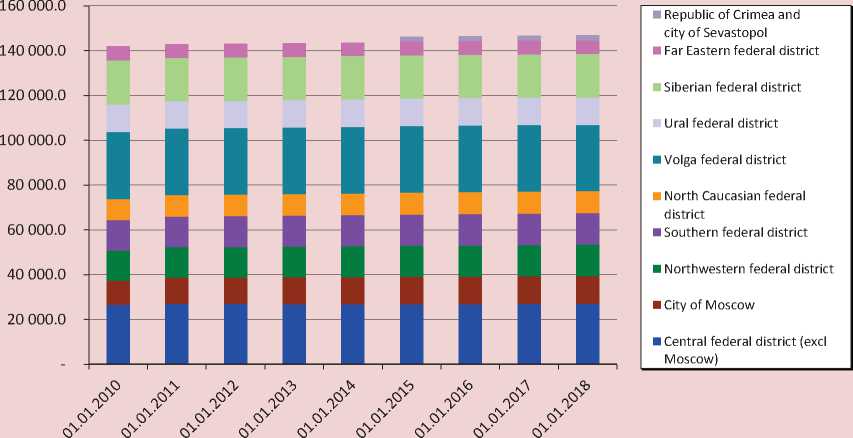
Source: Demography. Population size and composition. Available at: rosstat/ru/statistics/population/demography/#
Figure 4. Loans to the population in 2010–2017 per capita, thousand rubles

Calculated according to: Loans to resident individuals (regional breakdown). Available at: statistics/?Prtid=sors; Demographics. Population size and composition. Available at: rosstat_main/rosstat/ru/statistics/population/demography/#
The figure demonstrates that the highest value of loans granted to individuals is recorded in the Central, Volga, Siberian Federal districts and in Moscow, which generally corresponds to the distribution of the population in the country ( Fig. 3 ).
To compare data from different territories we use the debt load indicator calculated as the value of loans per inhabitant in the regional breakdown; the calculation results are presented in Fig. 4 .
During 2010–2014, banks in all the territories under consideration (except for the Siberian Federal District in 2010) were increasing the amount of consumer loans per inhabitant. During this period, the average volume of bank loans issued per inhabitant is approximately the same in the Ural, Far Eastern, Northwestern and Siberian federal districts; the values of this indicator are close to each other in the Southern, Volga and Central (excluding Moscow) federal districts. In the Siberian Federal District, the reduction in the amount of consumer loans in 2010 was due to the aggravation of the situation on the regional consumer loans market in the precrisis period and the subsequent stagnation of the market due to the development of a crisis situation in 20093. Since 2011, the situation in the Siberian Federal District has improved, the dynamics of loans issued to consumers as a whole corresponds to the dynamics of the similar indicator in other federal districts.
In 2015, there was a decrease in the analyzed indicator in all federal districts and in Moscow, but the largest decline was observed in Moscow, which is the leading region in the analyzed indicator, and the smallest decline – in the
North Caucasian Federal District, which is an outsider. It is due to the presence or absence of the possibility for individuals to reduce the volume of bank loans as part of the household budget sources, due to the difference in the level of income of the population in different territories. In other words, it is more difficult for people with low per capita monetary incomes to abandon bank loans as a source of their own budget than to cut their expenditures. On the contrary, the population with high per capita income has more opportunities to reduce their expenditures and, accordingly, to reduce the amount of bank loans they need.
To assess the role of bank loans as a source of household expenditure financing, we present the distribution of the ratio of issued loans to income, per capita, as an indicator of the debt burden, depending on per capita income (Fig. 5) .
According to the data shown in the Figure, there is a tendency to reduce the debt burden on bank loans with an increase in per capita cash income. The greatest debt burden on bank loans falls on households with per capita cash income under 35 thousand rubles.
The analysis of credit preferences of the population in their relations with the bank, which have a direct impact on the development of bank lending, should be supplemented by the analysis of the loans issued depending on the purpose, for which consumer loans are divided into two groups: housing loans and other (not related to housing) loans. Data on housing loans and other loans provided by banks to the population, per inhabitant, are presented in Figure 6 and Figure 7 .
Based on the data in Fig. 6 and Fig. 7, we can draw the following conclusions. In the analyzed period as a whole (except for 2015), there is an increase in loan debt per capita,
Figure 5. Distribution of the ratio of bank loans to income per capita, depending on the average per capita income of the population, for the period from 2010 to 2017
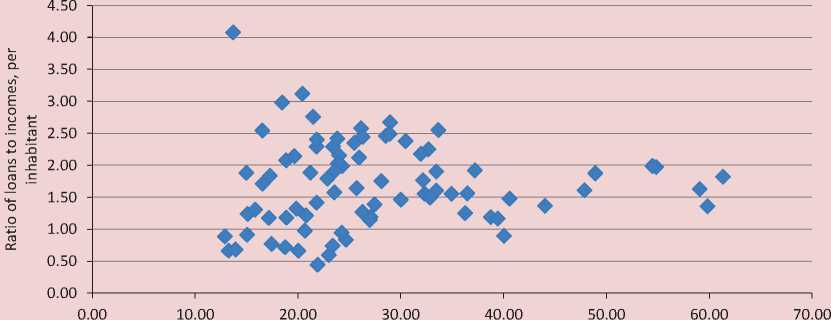
Average incomes per capita, thousand rubles
Source: our own compilation.
Figure 6. Bank housing loans issued to the population in 2010–2017, per inhabitant, thousand rubles
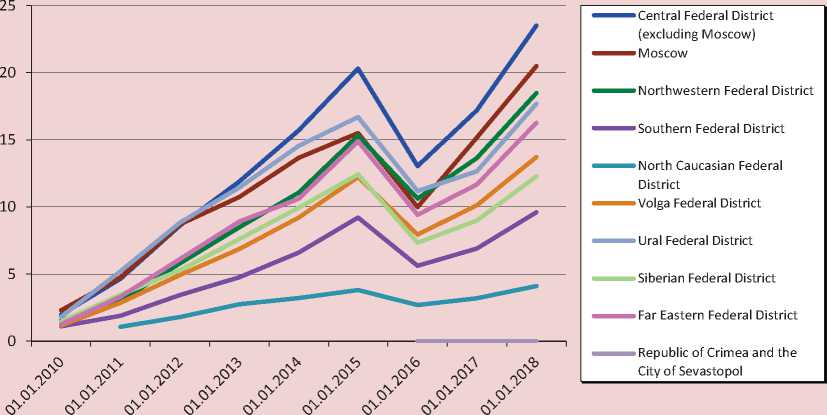
Calculation source: The volume of loans granted to resident individuals in rubles (by federal districts). Available at: http:// ; The volume of loans granted to resident individuals in foreign currency (by federal districts) Available at: =2018&TblID=302-31; Demographics. Population size and composition Available at: rosstat_main/rosstat/ru/statistics/population/demography/#
Figure 7. Other bank (other than housing) loans issued to the population in 2010–2017, per inhabitant, thousand rubles
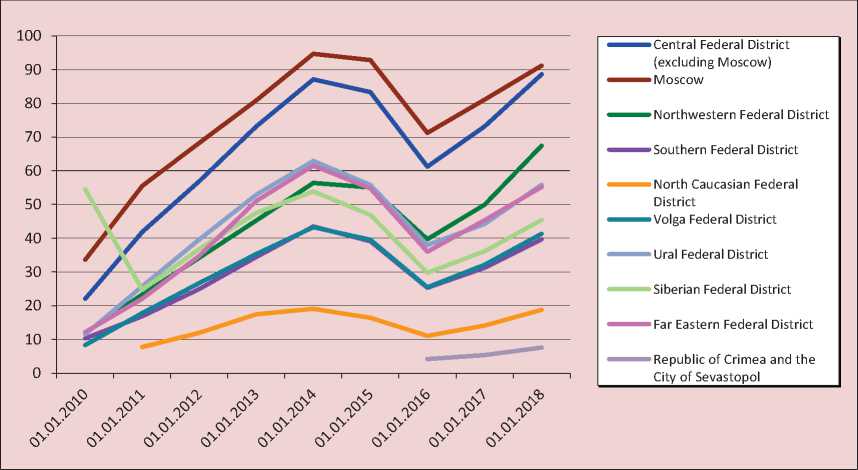
Calculation source: The volume of loans granted to resident individuals in rubles (by federal districts). Available at: http:// ; The volume of loans granted to resident individuals in foreign currency (by federal districts) Available at: =2018&TblID=302-31; Demographics. Population size and composition Available at: rosstat_main/rosstat/ru/statistics/population/demography/#
but the nature of growth on loans for different purposes differs. During 2015, all the territories under consideration are characterized by a reduction in the amount of consumer loans regardless of the purpose of lending, which is associated with the manifestation of the crisis consequences of the shock factors of 2014 that are due to the change in the exchange rate regime, imposition of Western sanctions, and which manifested, among other things, in the devaluation of the ruble, growth of inflation and bank interest rates, and a decline in real cash income as a criterion of creditworthiness of the population. In general, in the analyzed period, housing loans are characterized by an increase in the analyzed indicator at a higher rate compared to the growth of loans provided by banks for other purposes. The reason is that housing loans are aimed at financing the costs recognized by borrowers as necessary, and these costs are the last ones which borrowers are willing to give up; and the most important factor in the demand for housing loans is a sharp change in the conditions for the provision of such loans, especially a sharp rise in the cost of lending, which was manifested in 2015. However, since 2016, the value of the volume of housing loans issued by banks to the population has stabilized.
As for the dynamics of other (in addition to housing) loans provided by banks to the population per inhabitant, they are slightly different from the dynamics of the same indicator for housing loans. The decrease in the ratio of other loans per inhabitant begins in 2014, continues in 2015, and goes on more smoothly than the reduction in the same indicator for housing loans. The revealed difference is due to the greater willingness of the population to refuse to take bank loans on the purposes other than the purpose of purchasing housing, in the conditions of reducing/slowing the rate of income growth. The greatest ratio of the volume of housing loans per inhabitant is noted in the Central Federal District, other (except housing) bank loans – in the Central Federal District and in Moscow. This is due to the desire of the population of these territories to ensure a high level of consumption at high rates of growth of per capita cash income (see Fig. 1).
The dynamics of housing loans per capita in Moscow, which is the leader in terms of per capita cash income, indicates a lack of high demand for appropriate loans from borrowers, and does not have a significant positive impact on the development of the potential of providing housing loans by banks to the population.
With regard to the Siberian Federal District, the per capita reduction in Bank loans in 2010
(see Fig. 4) it was caused by overheating of the regional market of other loans (see Fig. 7), and is not reflected in the indicator on housing loans (see Fig. 6).
To identify the relationship between per capita cash income and the volume of loans issued by banks to the population, per capita, taking into account the purpose of the loan, we have calculated correlation indicators (Table) . Due to the small number of observations, we did not calculate the correlation indicators for the Republic of Crimea and Sevastopol.
Based on the data from the Table, we can conclude that there is a difference in the nature of the relationship between per capita income and consumer loans issued by banks, on the whole and in the context of different goals. In all the territories, there is a close relationship between per capita cash income and the amount of housing loan per inhabitant, which is due to the presence of banking standards for housing loans, high requirements of banks to potential borrowers, conscious attitude of borrowers to obtaining housing loans, and a long-term nature of housing loans. Other
Correlation between per capita income figures and the volume of consumer loans issued by banks, calculated per inhabitant, in the context of the territories
|
Territory |
Correlation between per capita cash income |
||
|
and the volume of consumer loans issued by banks, total, per inhabitant |
and the volume of housing loans issued by banks, per inhabitant |
and the volume of other loans (besides housing) issued by banks, per inhabitant |
|
|
Central Federal District (without Moscow) |
0.877046687 |
0.894418395 |
0.78486132 |
|
City of Moscow |
0.811653063 |
0.867667741 |
0.77789551 |
|
Northwestern Federal District |
0.827503958 |
0.901726913 |
0.79225995 |
|
Southern Federal District (without the Republic of Crimea and Sevastopol) |
0.729489162 |
0.87704183 |
0.66990952 |
|
North Caucasian Federal District |
0.544199941 |
0.828221918 |
0.4555237 |
|
Volga Federal District |
0.765579623 |
0.893204469 |
0.69472228 |
|
Ural Federal District |
0.745231175 |
0.858979629 |
0.69640223 |
|
Siberian Federal District |
0.204132178 |
0.837943606 |
0.26357253* |
|
Far Eastern Federal District |
0.710366917 |
0.861677582 |
0.64380227 |
|
* Excluding anomalous values of 2010. Source: our own calculations. |
|||
nature of the relationship is observed for other (besides housing) loans. The most significant relationship between the analyzed indicators (more than 0.69) is observed in the Central (without Moscow), Northwestern, Volga, and Ural federal districts and in Moscow. The relationship of per capita cash income and other (except housing) bank loans per borrower in the Far Eastern and Southern (without the Republic of Crimea and the city of Sevastopol) federal districts should be assessed as significant as well; however, when issuing loans to the population of these territories for purposes other than housing, banks take less account of borrowers’ incomes, which potentially entails an increase in the riskiness of credit investments.
The least close relationship between income and other (except housing) loans is noted in the North Caucasian Federal District. The weakening of correlation between per capita income and other (besides housing) loans per capita compared to the relationship of indicators for housing loans is due to the fact that banks not always assess the credit limit depending on the official cash income of borrowers, and also due to the fact that banks provide other (besides housing) loans to a limited number of borrowers. Both reasons are negative, because the former leads to an increase in high-risk debt and contributes to the formation of a bank portfolio of loans issued to individuals of poor quality. The latter reason is the consequence of either insufficient availability of bank lending services for the population, or a low credit quality of a large number of potential borrowers, which is illustrated by the lowest per capita income of the population of the Siberian and North Caucasian federal districts in comparison with the income of the population of other territories (see Fig. 1).
We note that all the territories of the Russian Federation, with the exception of the Siberian and North Caucasian federal districts have a significant correlation (more than 0.71) between per capita cash income and the total amount of loans issued by banks per inhabitant. The correlation of indicators of the Siberian Federal District was influenced by the abnormal reduction in the volume of consumer loans during 2010, and in absolute figures it was other loans that fell sharply, and housing loans per inhabitant did not decrease in dynamics.
The correlation between loans per inhabitant and per capita monetary income in the North Caucasian Federal District weak due to the weak correlation between incomes and the indicator for other (in addition to housing) loans, which does not have a positive impact on the formation of high-quality bank portfolios of consumer loans, contributes to the fact that banks accumulate potential risks due to the provision of consumer loans.
The fact that banks accumulate higher risks in connection with the expansion of consumer lending in modern conditions is confirmed by the regulator [34, p. 3]. Banks issue loans to borrowers with low credit quality at higher rates and do not focus on borrowers with high solvency, who are not interested in expensive bank loans. As a result, overdue debt can increase and revenues from lending decrease; and there may be problems with liquidity and capital adequacy [35, p. 165] due to the growing overdue.
Thus, it seems that the current situation with consumer lending does not promote the profitability of banks, because it is associated with significant financial costs to minimize credit risks, determines the growth of bank expenses for the formation of reserves for possible losses on loans and, accordingly, the reduction of profits. The development of the potential of issuing bank loans to the population should be positively affected by the expected4 increase in incomes of citizens, recognized as one of the areas that ensure the achievement of national development goals for the period up to 2024.
Conclusions
We have studied the volume of bank loans issued to physical persons and the income of the population in federal districts, with allocation of Moscow, the Republic of Crimea and Sevastopol; it allowed us to estimate activity of the population in the attraction of borrowed funds of banks in the budgets of households; and we make the following conclusions.
The problem of increasing the investment role of bank loans as a source of financing household expenditures aimed at the development of human capital is a complex one; it involves an interdisciplinary approach to its study, covers various areas, such as macroprudential regulation through the establishment of LTV, DSTI/PTI indicators, volatility of bank revenues from the conduct of classical banking activities (provision of loans to individuals), finance, household budgets, economic behavior of the population, financial literacy, social consequences of obtaining bank loans to finance personal expenses.
It was found that in modern Russian conditions, bank loans are used most actively by the population with per capita income up to 35 thousand rubles. When there is a decline in real incomes, people with higher per capita incomes abandon bank loans more actively, while in regions with small per capita incomes the demand for bank loans is generally maintained. Bank loans are largely used by households with small per capita monetary incomes to bridge the income-expenditure gap and find the money for current expenditures; such loans do not fulfill their purpose as an investment-stimulating tool in financing human capital development.
If in the loan portfolio of banks there are a lot of loans issued to low-income borrowers, and a ratio of the issued loans to incomes is high, then is means the increased risks for banks, and such a situation does not fully contribute to the formation of financial sources for the development of the bank itself and limits the potential for the development of lending to the population.
Attracting borrowers with high income, financially literate, consciously using the bank’s funds to invest in the development of their own knowledge and skills and improving the quality of life can be facilitated through the stabilization of the macroeconomic situation, keeping inflation within the inflation target, and reducing interest rates on loans. The expansion of lending to such borrowers will allow banks to form high-quality loan portfolios, and receive stable income from lending; it will strengthen the stability of banks, prevent the accumulation of potential risks of non-return, ease the pressure on regulatory capital, thereby increasing the potential for the development of bank lending.
The results can be used in further studies of the behavior of individuals in the banking market, in the study of the possibility of introducing macroprudential instruments into the Russian practice in accordance with the stimulating principle of the currently reformed banking supervision.
Список литературы Miroshnichenko O.S. People's incomes as a potential for development of bank lending: comparative analysis of Russian regions
- Golikov N.A., Golikov I.N., Yumanova N.N. Population debt load and suicide behavior risk: is there a connection? (Part I. Federal level). Suitsidologiya=Suicidology, 2016, vol. 7, no. 4 (25), pp. 72-83..
- Ivanitskii V.P., Aleksandrov S.A. Formation of behavioral finance as the natural stage of the human model evolution in economics. Ekonomika regiona=Economy of Region, 2017, vol. 13, no. 3, pp. 658-671. DOI: 10.17059/2017-3-2
- L'vova N.A., Pokrovskaya N.V., Ivanov V.V. Socially oriented taxation and how it is perceived (case study of a survey of economists-to-be). Ekonomicheskie i sotsial'nye peremeny: fakty, tendentsii, prognoz=Economic and Social Changes: Facts, Trends, Forecast, 2017, vol. 10, no. 4, pp. 196-211. DOI: 10.15838/esc.2017.4.52.11
- Rudenko D.Y. A comprehensive approach to the study of poverty in the region. Regional Research of Russia, 2014, vol. 4, no. 3, pp. 143-151. DOI: 10.1134/S2079970514030083
- Davis A., Kim J. Explaining changes in the US credit card market: Lenders are using more information. Economic Modeling, 2017, vol. 61, pp. 76-92. DOI: https://doi.org/10.1016/j.econmod.2016.11.025
- Ilyin V.A., Shabunova A.A., Uskova T.V., Gulin K.A., Chekavinskii A.N., Povarova A.I., Voroshilov N.V., M. Chzhiyun et al. Ekonomicheskoe razvitie regionov: opyt Rossii i Kitaya: monografiya . Vologda: Institut sotsial'no-ekonomicheskogo razvitiya territorii RAN, 2017. 402 p.
- Gamukin V.V. Structural change of gross regional product in the subjects of Ural federal district. Ekonomika regiona=Economy of Region, 2017, vol. 13, no. 2, pp. 410-421. DOI: 10.17059/2017-2-7
- Giltman M. Does location affect employment? Evidence from the High North of Russia. Journal of Urban and Regional Analysis, 2016, vol. 8 (1), pp. 21-36.
- Voronova N.S., Miroshnichenko O.S. Regional banks of Russia: problems of growth and development prospects. Finansy: teoriya i praktika=Finance: Theory and Practice, 2017, vol. 21, no. 4, pp. 40-53. 5671-2017-21-4-40-53. DOI: 10.26794/2587-
- Miroshnichenko O.S., Tarasova A.N. Sources of regional banks capitalization. Ekonomika regiona=Economy of Region, 2018, vol. 14, no. 1, pp. 303-314. DOI: 10.17059/2018-1-24
- Sinel'nikov-Murylev S.G., Radygina A.D (Eds.). Mau V. et al. Rossiiskaya ekonomika v 2016 godu. Tendentsii i perspektivy . Moscow: Izd-vo In-ta Gaidara, 2017. Vol. 38. 520 p.
- Sharinova G.A. The issue of population lending in Russian regions. Ekonomika sel'skogo khozyaistva Rossii=Russia's Agricultural Economy, 2017, no 3, pp. 81-84..
- Klapper L., Lusardi A., Panos G.A. Financial literacy and its consequences: Evidence from Russia during the financial crisis. Journal of Banking & Finance, 2013, vol. 37, pp. 3904-3923. DOI: https://doi.org/10.1016/j.jbankfin.2013.07.014
- Gathergood J., Weber J. Financial literacy, present bias and alternative mortgage products. Journal of Banking & Finance, 2017, vol. 78, pp. 58-83. jbankfin.2017.01.022 DOI: https://doi.org/10.1016/j
- Malkina M.Yu. Uneven provision of Russian regions with banking services. Finansy i kredit=Finance and Credit, 2017, vol. 23, no. 36 (756), pp. 2136-2158..
- Khatskevich E.M., Semer'yanova A.Yu., Tatarinova L.Yu. Loan affordability in Siberia amid decreasing domestic demand. Den'gi i kredit=Money and Credit, 2017, no. 11, pp. 35-42..
- Kleiner G.B. From "individual economics" to system economy. Voprosy ekonomiki=Economic Issues, 2017, no. 8, pp. 56-74..
- Yarasheva A.V., Makar S.V., Reshetnikov S.B. The credit strategies of the Russians as the reflection of the model of financial behavior. Finansy: teoriya i praktika=Finance: Theory and Practice, 2017, vol. 21, no. 6, pp. 138-153. DOI: 10.26794/2587-5671-2017-21-6-242-249
- Petukhov N.A. Population's loan debt in Russian regions. Vestnik Yuzhno-Ural'skogo gosudarstvennogo universiteta. Seriya: Ekonomika i menedzhment=Bulletin of South Ural State University, 2016, vol. 10, no.1, pp. 51-57..
- Ershov E.B., Kadreva O.N. Russian households' organized savings modeling: macro-approach, credit consideration. Ekonomicheskii zhurnal Vysshei shkoly ekonomiki=Higher School of Economics Economic Journal, 2015, vol. 19, no. 3, pp. 349-1385..
- Mamonov M.E. Market for Retail Loans in Russia: The Identification of Demand and Supply through the VECM Approach. Ekonomicheskii zhurnal Vysshei shkoly ekonomiki=Higher School of Economics Economic Journal, 2017..
- Fedorova E.A., Nekhaenko V.V., Dovzhenko S.E. The impact of Russian population's financial literacy on the behavior on a financial market (empirical assessment). Problemy prognozirovaniya=Forecasting Issues, 2015, no. 4, pp. 105-117..
- Burdyak A., Grishina E. Incomes and consumer lending. Ekonomicheskoe razvitie Rossii=Russian Economic Developments, 2016, vol. 23, no. 1, pp. 62-65..
- Berisha E., Meszaros J. Household debt, economic conditions, and income inequality: A state level analysis. The Social Science Journal, 2017, vol. 54, pp. 93-101. DOI: https://doi.org/10.1016/j.soscij.2016.11.002
- Berisha E. Yield spread and the income distribution. The Quarterly Review of Economics and Finance, 2017, vol. 65, pp. 363-377 DOI: https://doi.org/10.1016/j.qref.2016.12.002
- Voronov V.S., Ivanov V.V. The rise of cyber market for stock art: assets aggregation and the wealth of mass creativity. innovation management and education excellence vision 2020: from regional development sustainability to global economic growth proceedings of the 27th IBIMA conference. Milan, 2016, pp. 537-545.
- Ampudia M., Vlokhoven H., Żochowsk D. Financial fragility of euro area households. Journal of Financial Stability, 2016, vol. 27, pp. 250-262. DOI: https://doi.org/10.1016/j.jfs.2016.02.003
- Basnet H.C., Donou-Adonsou F. Internet, consumer spending, and credit card balance: Evidence from US consumers. Review of Financial Economics, 2016, vol. 30, pp. 11-22. rfe.2016.01.002 DOI: https://doi.org/10.1016/j
- Cerutti E., Claessens S., Laeven L. The use and effectiveness of macroprudential policies: New evidence. Journal of Financial Stability, 2017, vol. 28, pp. 203-224 DOI: https://doi.org/10.1016/j.jfs.2015.10.004
- Alpanda S., Zubairy S. Addressing household indebtedness: Monetary, fiscal or macroprudential policy? European Economic Review, 2017, vol. 92, pp. 47-73. DOI: https://doi.org/10.1016/j.euroecorev.2016.11.004
- Kukk M. How did household indebtedness hamper consumption during the recession? Evidence from micro data. Journal of Comparative Economics, 2016, vol. 44, pp. 764-786. jce.2015.07.004 DOI: https://doi.org/10.1016/j
- Gross M., Población J. Assessing the efficacy of borrower-based macroprudential policy using an integrated micro-macro model for European households. Economic Modeling, 2017, vol. 61, pp. 510-528 DOI: https://doi.org/10.1016/j.econmod.2016.12.029
- Pokrovskaia N.V., Sokolov B.I., Ivanov V.V. Tax reforms for sustainable economic growth of the national economy: case of China. Innovation management and education excellence vision 2020: from regional development sustainability to global economic growth. Proceedings of the 27th IBIMA conference. Milan, 2016, pp. 429-439.
- Potrebitel'skoe kreditovanie v Rossii: perspektivy i riski na osnove obsledovanii finansov domashnikh khozyaistv: analiticheskaya zapiska Departamenta issledovanii i prognozirovaniya Banka Rossii . Available at: http://www.cbr.ru/Content/Document/File/23500/analytic_note_170928.pdf (accessed: 10.01.2018).
- Miroshnichenko O.S. Finansovaya politika banka: portfel'nyi podkhod k upravleniyu kapitalom Moscow: Kreativnaya ekonomika, 2016. 218 p DOI: 10.18334/9785912921544

